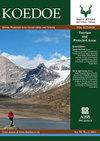The spatial distribution of the woodland communities and their associated environmental drivers in the Golden Gate Highlands National Park, South Africa
IF 1.1
4区 环境科学与生态学
Q3 BIODIVERSITY CONSERVATION
引用次数: 0
Abstract
The extreme variability in the topography, altitude and climatic conditions in the temperate Grassland Mountains of Southern Africa is associated with the complex mosaic of grassland communities with pockets of woodland patches. Understanding the relationships between plant communities and environmental parameters is essential in biodiversity conservation, especially for current and future climate change predictions. This article focused on the spatial distribution of woodland communities and their associated environmental drivers in the Golden Gate Highlands (GGHNP) National Park in South Africa. A generalized linear model (GLM) assuming a binomial distribution, was used to determine the optimal environmental variables influencing the spatial distribution of the woodland communities. The Coefficient of Variation (CV) was relatively higher for the topographic ruggedness index (68.78%), topographic roughness index (68.03), aspect (60.04%), coarse fragments (37.46%) and the topographic wetness index (31.33) whereas soil pH, bulk density, sandy and clay contents had relatively less variation (2.39%, 3.23%, 7.56% and 8.46% respectively). In determining the optimal number of environmental variables influencing the spatial distribution of woodland communities, roughness index, topographic wetness index, soil coarse fragments, soil organic carbon, soil cation exchange capacity and remote-sensing based vegetation condition index were significant (p 0.05) and positively correlated with the woodland communities. Soil nitrogen, clay content, soil pH, fire and elevation were also significant but negatively correlated with the woodland communities. The area under the curve (AUC) of the receiver operating characteristics (ROC) was 0.81. This was indicative of a Parsimonious Model with explanatory predictive power for determination of optimal environmental variables in vegetation ecology.Conservation implications: The isolated woodland communities are sources of floristic diversity and important biogeographical links between larger forest areas in the wider Drakensberg region. They provide suitable habitats for a larger number of forest species and harbour some of the endemic tree species of South Africa. They also provide watershed protection and other important ecosystem services. Understanding the drivers influencing the spatial distribution and persistence of these woodland communities is therefore key to conservation planning in the area.南非金门高地国家公园林地群落的空间分布及其环境驱动因素
南部非洲温带草原山脉的地形、海拔和气候条件的极端变化与草地群落与林地斑块的复杂镶嵌有关。了解植物群落与环境参数之间的关系对生物多样性保护至关重要,特别是对当前和未来的气候变化预测。本文研究了南非金门高地国家公园林地群落的空间分布及其相关环境驱动因素。采用二项分布的广义线性模型(GLM)确定了影响林地群落空间分布的最优环境变量。地形崎岖度指数(68.78%)、地形粗糙度指数(68.03)、坡向(60.04%)、粗糙碎片(37.46%)和地形湿度指数(31.33)的变异系数较高,而土壤pH、容重、砂质和粘土含量的变异系数相对较小(分别为2.39%、3.23%、7.56%和8.46%)。在确定影响林地群落空间分布的最优环境变量数时,粗糙度指数、地形湿度指数、土壤粗碎片、土壤有机碳、土壤阳离子交换容量和基于遥感的植被状况指数与林地群落呈显著正相关(p < 0.05)。土壤氮、粘粒含量、pH、火、海拔与林地群落呈显著负相关。受试者工作特征曲线下面积(AUC)为0.81。这表明该模型对确定植被生态中最优环境变量具有解释力和预测力。保护意义:孤立的林地群落是植物多样性的来源,也是更广阔的德拉肯斯堡地区更大森林区域之间重要的生物地理联系。它们为大量的森林物种提供了合适的栖息地,并庇护了一些南非特有的树种。它们还提供流域保护和其他重要的生态系统服务。因此,了解影响这些林地群落空间分布和持久性的驱动因素是该地区保护规划的关键。
本文章由计算机程序翻译,如有差异,请以英文原文为准。
求助全文
约1分钟内获得全文
求助全文
来源期刊

Koedoe
BIODIVERSITY CONSERVATION-
CiteScore
3.30
自引率
0.00%
发文量
10
审稿时长
20 weeks
期刊介绍:
Koedoe, with the subtitle ''African Protected Area Conservation and Science'', promotes and contributes to the scientific (biological) and environmental (ecological and biodiversity) conservation practices of Africa by defining the key disciplines that will ensure the existence of a wide variety of plant and animal species in their natural environments (biological diversity) in Africa.
 求助内容:
求助内容: 应助结果提醒方式:
应助结果提醒方式:


